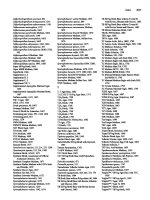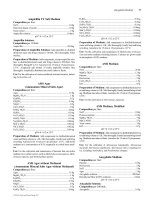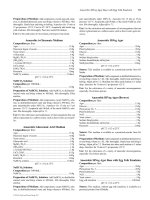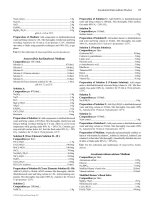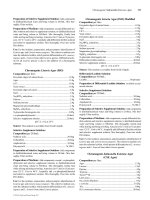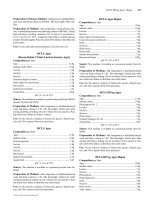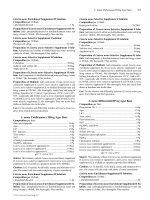Handbook of Small Electric Motors MAZ Part 12 doc
Bạn đang xem bản rút gọn của tài liệu. Xem và tải ngay bản đầy đủ của tài liệu tại đây (1.57 MB, 107 trang )
CHAPTER 5
ELECTRONICALLY
COMMUTATED MOTORS
Chapter Contributors
Duane C. Hanselman
Dan Jones
Douglas W. Jones
William H. Yeadon
5.1
5.1 BRUSHLESS DIRECT-CURRENT
(BLDC) MOTORS*
This chapter covers performance calculations and characteristics of the most com-
mon electronically commutated motors. The first motor to be covered is the brush-
less direct-current (BLDC) motor in several configurations.
Next, several configurations of the stepper motor are discussed. This is followed
by the switched-reluctance motor, which is really a specialized configuration of the
variable-reluctance stepper motor.
Brushless direct-current motors (BLDCs) are so named because they have a
straight-line speed-torque curve like their mechanically commutated counterparts,
permanent-magnet direct-current (PMDC) motors. In PMDC motors, the magnets
are stationary and the current-carrying coils rotate. Current direction is changed
through the mechanical commutation process.
In BLDC motors (Fig. 5.1), the magnets rotate and the current-carrying coils are
stationary. Current direction is switched by transistors. The timing of the switching
sequence is established by some type of rotor-position sensor.A typical rotor assem-
bly for an inner-rotor configuration with sensors and commutation magnet is shown
in Fig. 5.2. The three white devices mounted on the printed-circuit board are Hall-
effect switches.They are positioned next to the larger-diameter magnet wheel, which
causes them to switch high and low as the wheel changes from north to south as it
* Section contributed by William H.Yeadon,Yeadon Engineering Services, PC, except as noted.
rotates. The angular position of the Hall devices are adjusted to provide the opti-
mum firing angle for the application. Figure 5.3 shows via magnetic field–viewing
film the relative position of the motor magnet transition zone with respect to the
Hall device. The stator assembly for this is shown in Fig. 5.4. This motor has a low-
energy-product solid-plastic ring magnet with magnetic poles superimposed on it.
Another type of motor has a rotor with solid magnet arcs, as shown in Fig. 5.5.
5.2 CHAPTER FIVE
FIGURE 5.1 BLDC motor.
FIGURE 5.2 BLDC rotor assembly.
ELECTRONICALLY COMMUTATED MOTORS 5.3
FIGURE 5.3 BLDC rotor showing magnetic pole transitions.
FIGURE 5.4 BLDC stator assembly.
5.1.1 Basic Configuration of BLDC Motors
Outer-Rotor Motors. These motors are generally used where relatively high rotor
inertia is beneficial to system performance. Common applications are computer disk
drives and cooling fans. Construction is shown in Figs. 5.6 and 5.7.
The rotor assembly in Fig. 5.6 consists of a flexible magnet with four poles mag-
netized on it. It is enclosed by a magnetically soft steel cup or housing.A shaft which
5.4 CHAPTER FIVE
FIGURE 5.5 BLDC rotor assembly with core segment magnets.
FIGURE 5.6 BLDC outer rotor assembly.
allows the rotor to turn with respect to the stator is attached to the center of the steel
housing.
The stator assembly (Figs. 5.8 and 5.9) consists of a lamination stack with coils of
wire wrapped around the pole pieces. This is supported by a mounting base which
also contains a bearing support and a control circuit. This motor’s poles are alter-
nately magnetized N-S-N-S.
As the rotor turns, the currents are turned off in one winding set and turned on in
the other set by the Hall switch. This results in an S-N-S-N magnetization in which
the S poles are induced at the interpoles and the poles where no current exists in the
windings. This keeps the rotor turning. A close observation of this structure shows
ELECTRONICALLY COMMUTATED MOTORS 5.5
FIGURE 5.7 Outer-rotor BLDC motor rotor and stator assembly.
FIGURE 5.8 Outer-rotor BLDC stator diagram.
that it is in fact a single-phase motor and, as such, will have rotor positions where
there is zero torque. This could result in failure to start. This is overcome by placing
interpoles between the wound poles, as shown in Fig. 5.10. The magnet provides
some position bias, which always results in rotation when the pole is energized.
Some other methods used to start these single-phase motors are shown in Figs.
5.11 and 5.12. In the case of Fig. 5.11, the reluctance torque produced by the magnet
5.6 CHAPTER FIVE
FIGURE 5.9 Outer-rotor BLDC wound stator assembly.
FIGURE 5.10 Outer-rotor motor diagram.
causes the rotor to line up over the pole. When the coils are energized, the field
resulting from the energized coil appears to move across the face of the pole in the
direction of the wider section of the pole that is closest to the gap. This starts rota-
tion, which may then be maintained by alternately reversing the winding currents.
The structure shown in Fig. 5.12 is another method of providing an unbalanced mag-
netic circuit which causes the rotor to have a preferred resting position in the unen-
ergized state that is different from that of the energized state.
All of the motors just discussed are single-phase motors.Although this is proba-
bly the case for most outer-rotor motors, it is quite possible to build a multiphase
motor in this configuration, as shown in Fig. 5.13.
ELECTRONICALLY COMMUTATED MOTORS 5.7
FIGURE 5.11 Stator with reluctance notches.
FIGURE 5.12 Stator with reluctance holes.
Inner-Rotor Motors. If one simply inverts the outer-rotor motor diagrammed in
Fig. 5.8, the device shown in Fig. 5.14 is generated.This is also a single-phase device,
and it would operate in the same fashion as the outer-rotor motor.
Some observations need to be made about these motors. The outer-rotor motor
has much more magnetic material than the inner-rotor device, which means it is
capable of more flux when the identical materials are used. It would be necessary to
use a higher-energy-product magnet to get the same performance from an inner-
rotor motor.
The inertia of the inner-rotor motor is lower because of its smaller rotor diame-
ter.Therefore, it accelerates more rapidly than the outer-rotor motor.
5.8 CHAPTER FIVE
FIGURE 5.13 Multiphase outer-rotor motor.
FIGURE 5.14 Single-phase inner-rotor motor.
Most inner-rotor motors have multiple phases in an effort to reduce the starting
problems associated with single-phase motors.The stators may have salient poles or
distributed windings. Figure 5.15 illustrates a three-phase four-pole salient-pole
machine. Here the rotor is a magnetically soft steel core with magnet arc segments
bonded to it.As the phases are switched in sequence A-B-C, the rotor moves to line
up with the subsequent phase. When the rotor has moved 180° electrical, it is neces-
sary to reverse the current in the windings, starting with phase A, in order to prop-
erly polarize the stator poles with respect to the magnet poles.
ELECTRONICALLY COMMUTATED MOTORS 5.9
FIGURE 5.15 Multiphase inner-rotor motor.
In order to properly switch the coil currents at the right time and in the right
order, the control electronics must know the rotor position. This is usually accom-
plished by means of Hall-effect devices, encoders, or counter-emf sensing.
Salient-pole machines have inherently high torque perturbation characteristics
because of the abrupt permeance changes as the rotor moves from pole to pole.This
can be reduced by distributing the windings over several stator teeth per pole. This
is illustrated in Fig. 5.16.
Special Configurations—Slotless Brushless Inner-Rotor Motors. One variation
of the distributed-winding multiphase brushless motor is the slotless brushless
motor.As shown in Fig. 5.17, the winding distribution is similar to that of the stator
shown in Fig. 5.16. However, the stator section has no teeth. The advantage of this
type of motor is that there are no variations in permeance as the rotor moves.Thus,
there are no torque perturbations or cogging. There is, however, a price to be paid.
The lack of teeth increases the effective air gap, thereby lowering the available flux.
Another variation is the axial airgap motor.This motor is illustrated in Fig. 5.18.
It has a stator with triangular coils (Fig. 5.19) and a disc rotor which is alternately
magnetized NS-NS-NS-NS through its thickness. The stator coils (Fig. 5.20) are
mounted to a nonmagnetic substrate, while the rotor disc is mounted to a magneti-
cally soft steel.The advantage of this motor is that, like the other slotless motor, it is
low cogging, but it also has relatively high inertia.
5.10 CHAPTER FIVE
FIGURE 5.16 Inner rotor distributed-wound stator.
FIGURE 5.17 Inner rotor slotless stator.
Summary. Brushless DC motors can be put into three basic categories according
to their structure:
●
Outer-rotor motors
●
Inner-rotor motors
●
Special-configuration motors
Table 5.1 presents a relative comparison of the inner- and outer-rotor types.This
assumes the same physical size motor operating at the same speed and torque.
ELECTRONICALLY COMMUTATED MOTORS 5.11
5.1.2 Sizing and Shaping the Motor
Mechanical Parameters. All designs must start with some parameters and
assumptions. Generally, there is a specification of some type which includes output
performance, available power input, mechanical mounting method, and means of
connecting the load. First, look at the intended application and determine whether
an inner- or outer-rotor motor would be the first choice. Some common indicators
are charted in Table 5.2.
Establishing Motor Cross-Section Dimensions. It should be noted here that
magnetic-circuit design is an interactive process and that the following rules are just
guidelines to establish a starting point. At this point, the outside diameter of the
motor and the shaft diameter have been selected. The next task is to roughly pro-
portion the magnetic-circuit components to establish a starting point for the design.
First look at the outer-rotor motor (Fig. 5.21). Then look at the inner-rotor motor
(Fig. 5.22).
The shaft and bearing space has already been established, so the space for active
material that remains is the area between the shaft hole and the outside diameter.
Next, decide on the air gap. Gaps on the order of 0.020 to 0.040 in per side are very
common. The smaller the air gap, the more flux that is available, but the higher the
value of cogging torque. Manufacturing tolerances on stack diameter and magnet
thickness generally dictate a gap somewhere in the range stated. Start with the
smallest gap your factory can comfortably hold. If in doubt, try 0.030 in to start.
In order to set the rotor and stator magnetic circuit dimensions, you must make
some assumptions with respect to the level at which you will work the materials.This
is accomplished by setting the flux densities in the magnetic circuit as outlined in
Table 5.3.
FIGURE 5.18 Axial air gap brushless dc motor.
5.12 CHAPTER FIVE
FIGURE 5.19 Axial air gap rotor with magnets.
FIGURE 5.20 Axial air gap stator with windings.
ELECTRONICALLY COMMUTATED MOTORS 5.13
TABLE 5.1 Comparison of Outer-Rotor and Inner-Rotor Motors
Outer rotor Inner rotor
Single phase or multiphase. Single phase or multiphase.
Can be wound with dc armature-winding Requires ac stator-winding
equipment. equipment (more expensive).
Bifilar windings can be employed on single- Salient-pole machines utilize more copper.
phase motors; 50% copper utilization.
Available copper space on distributed- Distributed-winding motors provide
winding motors is less than on inner-rotor smoother performance and better copper
types. utilization.
Shorter end turns yield lower inductance Longer end turns yield higher inductance and
and less copper loss. more copper loss.
Greater rotor inertia. Lower rotor inertia.
Less torque perturbation. More torque perturbation.
Slower acceleration. Fast acceleration.
Lower-energy magnets can be used. Higher-energy magnets required.
TABLE 5.2 Inner-Rotor Versus Outer-Rotor Motor Applications
Requirement Inner rotor Outer rotor
Rapid acceleration Very good Poor
Heat dissipation Very good Poor
Low cogging Okay Good
Pump application Okay Good
Disk-drive application Poor Very good
Fan application Poor Very good
High side load Good Poor
Use with speed reducers Good Poor to okay
Reversible Very good Poor
Rotor Back Iron. In the outer-rotor motor, this is usually a steel cup of some kind.
To determine its thickness, keep in mind that the flux has a long steel path that
requires mmf to overcome. Set the flux density equal to 75 kline/in
2
.
Then:
B = A =
But you don’t yet know how much flux will be needed.You do know, however, that
it will be constant on a per-pole basis.This allows you to proportion the steel hous-
ing and lamination sections based on the relative flux densities given in Table 5.3.
Taking the nominal values and setting the stator teeth as 1.0, you can define ratios
for the remaining parts. There are still some problems to overcome before you can
proceed.You have not yet decided on the number of poles or teeth.
Poles and Teeth. Some general rules on selecting the number of poles, teeth, and
phases are presented in Table 5.4.
φ
ᎏ
B
φ
ᎏ
A
Number of Phases. Single-phase motors have poor conductor utilization, high
torque ripple, and null zones that may create starting problems, but they are easy to
wind and low cost and require only one or two power switches.
Two-phase motors also have poor conductor utilization, but the null zones are
eliminated, the torque ripple is greatly reduced,and the cost is higher because a min-
imum of four power switches are required.
Three-phase motors have better conductor utilization, no starting problems, and
greatly reduced torque ripple; they can get by with as few as three power switches,
but they generally cost more to wind.
Increasing the number of phases to four or greater realizes small gains in copper
utilization and torque ripple, but the costs of winding and power switches usually
outweigh the gains.
5.14 CHAPTER FIVE
FIGURE 5.22 Inner-rotor motor
FIGURE 5.21 Outer-rotor motor
As a starting point then, assuming that performance is as important as cost, the
three-phase motor is a good choice.
Number of Poles. Some general rules of thumb to consider when selecting the
number of poles are the following:
1. As the total number of poles increases, the requirement for rotor and stator back
iron decreases because the total flux is spread over more poles reducing the den-
sity.
2. Since less back iron is needed, more space is available for windings, allowing for
a reduction in copper losses.
3. More poles have more parts and cost more money.
Two-pole motors require substantial back iron and long winding spans, which
means more expensive winding equipment. Four-pole motors require about half the
back iron and have shorter coil spans.Although the equipment required may be the
same as for two-pole motors, four-pole motors have shorter end turns—therefore
less mutual inductance, less copper loss, and an easier time in winding.
ELECTRONICALLY COMMUTATED MOTORS 5.15
TABLE 5.3 Preferred Flux Densities
Flux density
Magnetic path section kline/in
2
T
Rotor back iron 70–80 1.09–1.24
Stator tooth tips 50–70 0.78–1.09
Stator teeth 110–125 1.71–1.94
Stator yoke section 80–100 1.24–1.55
TABLE 5.4 Effects of Changing Number of Poles,Teeth, and Phases
Effect on design factors
Active
material
Change Cogging Speed Torque utilization Cost
Number of
poles
Increased Decreases Decreases Increases Increases Increases
Decreased Increases Increases Decreases Decreases Decreases
Number of
teeth
Increased Decreases No change No change Increases Increases
Decreased Increases No change No change Decreases Decreases
Number of
phases
Increased Decreases No change No change Increases Increases
Decreased Increases No change No change Decreases Decreases
Six-pole and higher motors allow for some additional gains in copper utilization
and reduced back iron, but manufacturing costs and control-circuit costs start
increasing disproportionately. So, barring a requirement for high torque, low speed
or low cogging, a four-pole motor is also a good place to start.
Number of Teeth. So far, you have picked three phases and four poles. The next
major item is the number of teeth. There are many combinations of teeth and poles
that will work for motors having two, three, four and more phases. Common num-
bers of teeth for two-phase motors are 8, 12, 16, 24, and 48. Common three-phase
numbers are 6, 9, 12, 15, 24, 36, and 48. There are obviously other numbers of teeth
that will work for these motors. These are just some of the common ones. As the
number of teeth selected increases, the number of slots available for winding also
increases, resulting in more coils per pole. In general, one should choose the lowest
number of teeth possible that will provide a reasonable winding pattern.
Some things to keep in mind as combinations of teeth, poles, and phases are cho-
sen are the following:
●
Cogging. A torque perturbation occurs every time a magnet pole tip passes a sta-
tor tooth. Even numbers of teeth and poles cause a greater perturbation than
uneven numbers because at any given time there are more pole tips passing teeth.
This can be addressed by using an uneven number of teeth versus poles,which gives
fewer poles passing teeth at a given time, or by skewing the stator or the magnets.
●
Manufacturability. Increasing the number of teeth to improve performance has
its limits. As the number of teeth increases, the laminations may become difficult
to punch, or the teeth may bend easily as the slots are wound.
For this example, choose 12 teeth. Therefore, you have chosen 3 phases, 4 poles
and 12 teeth.
To estimate the size of the respective components, look at the motor section in
Fig. 5.23 and note the flux paths.
The flux from any one pole of this four-pole motor travels through the teeth to
the stator yoke, then splits through the yoke, goes back through the teeth under the
5.16 CHAPTER FIVE
FIGURE 5.23 Outer-rotor motor flux path.
adjacent magnet pole across the air gap, goes through the magnet, splits through the
rotor yoke, and goes back to the originating magnet.The magnet sets up the flux; all
the flux goes across the gap (except for leakage), into the tooth tips, and through the
teeth.When proportioning the sizes, refer to Table 5.5.
ELECTRONICALLY COMMUTATED MOTORS 5.17
TABLE 5.5 Nominal Flux Densities
Magnetic-circuit
Nominal flux density, kline/in
2
component Outer rotor Inner rotor
Stator teeth 115 115
Stator tooth tips 60 60
Stator yoke 90 75
Rotor yoke 75 90
Note that the stator and rotor yoke densities are inverted for the inner- and outer-
rotor motors. This is because the short path can afford a higher density without
resulting in too much mmf drop.
Since the flux density is inversely proportional to the area (B =φ/A), and the area
is proportioned to the width of the magnetic-circuit component times the length of
the stack L
stk
, the widths may be ratioed directly according to the flux density in
Table 5.5.
Ratio all components to the teeth as follows:
A
sy
= Y
ws
⋅ L
stk
where L
stk
= stack length
∴Y
ws
∝≈0.64 × total tooth width
The density ratio is divided by 2 because of the flux split.
A
tt
= T
tw
⋅ L
stk
∴T
tw
∝≈2
A
ry
= Y
wr
⋅ L
s
∴Y
wr
∝≈0.75 × total tooth width
In the case of the outer-rotor motor, the length of the shell L
s
is usually longer
then the stator stack, so Y
wr
is more in the range of 30 to 40 percent of total tooth
width.
To estimate the width of the teeth, assume that the area available after subtract-
ing magnet area, air gap area, and stator yoke is to be divided up so that the slot area
is approximately 2.5 times the tooth area. In this case, tooth area is the tooth width
times its length in the radial direction.Assume straight teeth with parallel sides.Then
take the total tooth width and divide it by the number of teeth per pole you have
chosen. In this case, the number is 3. These dimensions may need to be modified to
balance mmf drops once the magnetic circuit is solved.
115
ᎏ
75(2)
115
ᎏ
60
115
ᎏ
(90)(2)
Tooth-Tip Shapes. At this point, there are some things that need to be considered
about the shape of the tooth tips.The outer-rotor motor (Fig. 5.21) has a stator that
is much like a brush-type dc-motor armature, and they can be wound with similar
equipment.The tooth-tip thickness T
tt
(Fig. 5.24) should be large enough to keep the
region from saturating as the magnet pole tips pass the edge of the tooth tip.This will
reduce the torque perturbations and audible noise.A radius should be added at posi-
tion 1 to allow for easy entry of the magnet wire and at position 2 to reduce magnetic
saturation of this region.The width of the slot opening W
so
should be wide enough to
allow the largest-diameter wire you intend to use to be easily wound in place. It
5.18 CHAPTER FIVE
FIGURE 5.24 Outer-rotor tooth shapes.
should be kept small enough so that the magnet wire will be easily retained after the
winding operation is complete.
The inner-rotor motor (Fig. 5.25) follows the same rules with respect to tip thick-
ness as the outer rotor design. Some of the significant differences occur with the
width of the slot opening and the shape of the slot. If the stator is going to be wound
with a needle or gun winder,W
so
must be sufficient to allow for the needle width and
lateral motion. If the stator coils are going to be wound on forms and then inserted
into the stator with ac-motor-type inserters, the following rules apply (Fig. 5.26):
1. The slot depth D to the slot width W
s
, D/W
s
ratio should be as great as possible,
with 4 being a good value and 3 being the minimum value.
2. The slot bottom shape is not critical. Round or square will work, but round is eas-
ier to fill.
3. The angle α should be between 15 and 30 degrees.
An important rule to remember when establishing part dimensions is that the
width of any part should be 1.5 times the thickness of the material. Failure to follow
this rule results in part distortion and die wear. The material should be selected
based on cost, induction, and core loss requirements.
Structural Magnetic Materials. There are some parts of the motor magnetic cir-
cuit that generally wind up being used for mechanical structural purposes as well.
The outer-rotor motor in Fig. 5.23 has a rotor yoke which is used to contain the mag-
nets as well as serve as a flux path.The inner-rotor motor in Fig. 5.24 has a rotor core
to which the magnets are bonded.This core serves as the magnetic rotor yoke as well
as the means of attaching the output shaft to the magnets. These materials are usu-
ally a magnetically soft steel of the type ANSI CRS 1008 to 1026. It is not a require-
ment that theses parts be laminated because the direction of the flux in them does
not change; therefore, there are no core losses.A typical magnetization curve of this
material is shown in Fig. 5.27.
ELECTRONICALLY COMMUTATED MOTORS 5.19
FIGURE 5.25 Inner-rotor tooth shapes.
FIGURE 5.26 Inner-rotor tooth proportions.
Rotor Inertia. The following method for calculating rotor inertia is based on the
assumption that all parts of the rotor rotate around the center of the shaft.
For the outer-rotor motor in Fig. 5.28, calculate the inertia of each part separately,
then add the parts together for the total rotor inertia. First, calculate the inertia of
the shaft:
J
shaft
= 0.0184
4
L
shell
D
s
ᎏ
2
5.20 CHAPTER FIVE
FIGURE 5.27 Unannealed 1020 CRS housing material.
FIGURE 5.28 Outer-rotor inertia.
Then calculate the inertia of the disk:
J
D
= 0.0184
4
L
d
− 0.0184
4
L
d
Next, calculate the inertia of the shell:
J
shell
= 0.0184
4
L
shell
− 0.0184
4
L
shell
Then calculate the inertia of the magnets (see Table 5.6 for magnetic density):
J
mag
=
4
−
4
L
mag
(mag density)
ᎏᎏᎏ
772
D
rm
ᎏ
2
L
mag
(mag density)
ᎏᎏᎏ
772
D
ri
ᎏ
2
D
ri
ᎏ
2
D
ro
ᎏ
2
D
s
ᎏ
2
D
ro
ᎏ
2
ELECTRONICALLY COMMUTATED MOTORS 5.21
TABLE 5.6 Densities of Common Magnetic Materials
Density
Material lb/in
3
oz/in
3
g/cm
3
Bonded ferrite 0.134 2.14 3.71
Sintered ferrite 0.177 2.83 4.90
Alnico 0.264 4.22 7.31
Samarium cobalt 0.302 4.83 8.35
Neodymium-iron-boron 0.271 4.34 7.50
Finally:
J
rotor
= J
s
+ J
D
+ j
shell
+ J
mag
Now, consider the rotor of the inner-rotor motor (Fig. 5.29).
First:
J
shaft
= 0.0184
4
L
shaft
Then:
J
mag
=
4
−
4
Assuming the hub is steel, it follows that:
J
hub
= 0.0184
4
L
hub
− 0.0184
4
L
hub
J
rotor
= J
shaft
+ J
mag
+ J
hub
D
s
ᎏ
2
D
rm
ᎏ
2
L
mag
(mag density)
ᎏᎏᎏ
772
D
rm
ᎏ
2
L
mag
(mag density)
ᎏᎏᎏ
772
D
ro
ᎏ
2
D
s
ᎏ
2
5.1.3 Stator Winding Design Considerations*
Brushless dc motors initially were designed in large numbers for spindle drives in
Winchester disk drives. The early designs were three-phase, later moving to two-
phase and then one-phase, due to the very slow start-up requirements, very small
friction loads, and the need to reduce unit cost at all levels. The industrial and
machine tool markets started with and continue to use three-phase BLDC motors in
their variable-speed, variable-load, high-start-up applications. The overwhelming
popularity of three-phase BLDC motors focuses this subsection toward three-phase
windings. Many of the initial design activities for various winding patterns can be
traced back to the 1920s and earlier based on work done on three-phase ac windings.
This subsection reviews the various winding line connections, the key winding
patterns and hookups, various winding constants, and winding selection and design
techniques.
Basic Winding Configurations. There are other basic decisions that must be made
by the design engineer before a BLDC motor design can commence. Previously
defined is the number of phases, which is three here. Next in importance is the num-
ber of poles. The use of two poles is waning, and the use of six or eight poles is
increasing. Four-pole BLDC motors are among the most popular used today. Two-
and four-pole BLDC motor designs are used here, but the rules for two and four
poles can be extended to higher pole counts.The number of stator slots (and teeth)
and the winding pattern are key design decisions.This section is dedicated to review-
ing the important parameters of these two design decisions.
In a three-phase motor there are three windings or phases positioned 120° elec-
trical apart. Figure 5.30 shows the location of 6 coils in a representative 12-slot sta-
tor.A two-pole rotor (not shown) will rotate as the three windings are energized in
sequence A-B-C, as A-A′, B-B′, and then C-C′ are energized sequentially.The three-
phase winding always develops positive starting torque, no matter where the rotor
starts its motion.
5.22 CHAPTER FIVE
FIGURE 5.29 Inner-rotor inertia
* Subsection contributed by Dan Jones, Incremotion Associates.
There are many winding line connections that can be used in three-phase drive
systems. Figure 5.31 illustrates the various configurations. The half-wave wye is the
simplest three-phase line configuration (Fig. 5.31a). It uses three power lines and
one return line (four leads).The excitation is shown adjacent to the schematic in Fig.
5.31a. Only 33 percent (one lead) of the half-wave wye windings are energized at
any time in operation. The second wye winding, the full-wave wye (Fig. 5.31b) has
only three leads but 66 percent (two leads) of the windings are in operation simulta-
neously. The excitation scheme is shown to the right of the schematic.
The third major winding connection pattern is the delta, shown in Fig. 5.31c. It
possesses the same excitation scheme as the full-wave wye. The delta winding con-
figuration has been used more extensively than the wye in fractional-horsepower
(≤746 W) motor applications.The wye is more popular with the larger-sized integral-
horsepower BLDC motor users.The final winding to be reviewed is the independent
winding line connection (Fig. 5.31d). In this scheme, each winding is independent of
its neighbor. The excitation scheme is more complicated, but each winding can be
operated in parallel, thereby distributing the total current.The windings are still sit-
uated 120° electrical away from each other.This winding configuration has seen lim-
ited use to date.
The most popular winding line configurations are the full-wave wye and the
delta. In a balanced wye configuration, the line and coil (phase) currents are equal,
ELECTRONICALLY COMMUTATED MOTORS 5.23
FIGURE 5.30 Basic 3-phase winding layout.
the neutral current is zero, and the line-to-line voltage is ͙3
ෆ
times the phase voltage.
In a balanced delta connection, the line-to-line and coil (phase) voltages are equal,
but coil currents are 1/͙3
ෆ
times the line-to-line currents.
Key Winding Patterns. There are many types of winding patterns that can be uti-
lized. Four major winding patterns are listed here:
1. Constant integral pitch—lap winding (full)
2. Variable pitch—concentric winding
3. Constant fractional pitch—lap winding for even or odd stator slots
4. Half-pitch
Each of these winding patterns has two coils per stator slot.There is one winding
type designated, a consequent pole winding where there is only a single coil per slot.
Consequent pole windings are very popular in single-phase ac motors of fractional-
horsepower size.
Table 5.7 is revised from Veinott and Martin (1987). It displays the various sta-
tor slot and rotor pole combinations along with the maximum number of parallel
circuit combinations with a specific slot and pole combination. For purposes of sim-
plicity, either 12- or 24-slot stators are used here to illustrate the various winding
patterns. In one case, a 15-slot stator is used to illustrate an odd-slot fractional-pitch
lap winding.
5.24 CHAPTER FIVE
FIGURE 5.31 Popular 3-phase BLDC motor winding line connections:
(a) wye (half wave), (b) wye (full wave), (c) delta, and (d) independent.
If one uses a 12-slot stator winding, there are two full-pitch integral lap windings
available, one for two poles and the other for four poles.
P × Ph = nS (5.1)
where P = number of poles
Ph = number of phases
S = number of stator slots
n = integer number 1, 2, 3, n
If P = 2, Ph = 3, and S = 12, then n = 2, an integer. Figure 5.30 shows the basic
winding-slot pattern for a 12-slot 2-pole 3-phase 2-coils-per-pole-per-phase (n = 2)
configuration. The coil pattern for this winding configuration is shown in Figs. 5.32
and 5.33 as a series wye line configuration and as a parallel wye line configuration,
respectively.There are really 12 coils used in this design, but only 6 are shown.There
are two 1- to 7-throw coils—one inserted on the right side (CW direction), the sec-
ond inserted on the left side (CCW direction), and doubles on the other five coils
also, inserted as described previously. Note the position of the teeth for the 12-slot
stator.The slot pitch (adjacent slot to slot) is 360/12 or 30° mechanical or electrical.
The angular location for the phase 2 winding (CW direction) is only 60°. It is sup-
posed to be 120°. Symmetry solves the problem if 180° (polarity change) is added to
the 60° to achieve 240° mechanical or electrical.So the 1,2,3 winding phase hookups
displayed in Fig. 5.32 will yield a CCW rotation.
The series and parallel hookup options are very important from a practical aspect
of magnet wire size selection. It is easier to pack smaller-sized magnet wires in a
ELECTRONICALLY COMMUTATED MOTORS 5.25
TABLE 5.7 Slots Versus Poles Versus Parallel Hookups Versus Coils per Pole per Phase
2 Poles 4 Poles 6 Poles 8 Poles
Coils Coils Coils Coils
per per per per
Slots phase phase phase phase
or per per per per
coils Circuits pole Circuits pole Circuits pole Circuits pole
621 — — —
911
1
⁄2 ———
122241 — —
15 1 2
1
⁄2 11
1
⁄4 ——
18 2 3 2 1
1
⁄2 61 —
21 1 3
1
⁄2 11
3
⁄4 NP* X —
242442NPX81
27 1 4
1
⁄2 12
1
⁄4 31
1
⁄2 11
1
⁄8
30 2 5 2 2
1
⁄2 NP X 2 1
1
⁄4
33 1 5
1
⁄2 12
3
⁄4 NP X 1 1
3
⁄8
3626436 2 41
1
⁄2
39 1 6
1
⁄
2 13
1
⁄
4 NP X 1 1
5
⁄
8
42 2 7 2 3
1
⁄2 NP X 2 1
3
⁄4
45 1 7
1
⁄
2 13
3
⁄
4 32
1
⁄
2 11
7
⁄
8
482844NPX82
*NP = not practical.

